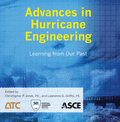An Engineering Approach for Modeling Hurricane Extreme Waves Using Analytical and Numerical Tools
Publication: Advances in Hurricane Engineering: Learning from Our Past
Abstract
This work aims to evaluate the ocean wave statistics (i.e., significant height, peak period, mean wave direction, and spectral form) under hurricane events, at any geographical point and coastal location by employing two different approaches. First, by the use of classical fast and mid-accurate analytical engineering tools comparing three classical set of equations (Bretschneider 1990; Young 1988; and the Shore Protection Manual SPM 1984) and their further validation against instrumental data provided by the National Data Buoy Centre (NDBC). On the other hand, by using a high-accurate numerical approach is proposed, using the unstructured-mesh SWAN spectral wave model (Zijlema et al. 2010), comparing the results between the stationary and non stationary approach, and validating the nearshore ocean wave characteristics with measured data at different water depth locations. Both approaches are forced with accurate pressure and wind speed fields obtained with classical and well-known parametric equations (i.e., Holland 1980; Hydromet-Rankin Vortex 1980; and Bretschneider 1990), integrated with the NCEP/NCAP wind fields. Hurricane waves for both approaches are validated with instrumental data from the NDBC measured for hurricanes: Katrina (2005); Gilbert (1998); Mitch (1998); Wilma (2005); and Ike (2008). Comparisons between both approaches have been made. Additionally, user recommendations and a sensitivity analysis about the optimization and design of the numerical mesh are presented, taking into account an efficient design of the numerical finite element mesh of the model, and the optimal spatial distribution of the nodes and elements along the hurricane track. The present study provides an efficient and easy engineering-mathematical tool to evaluate the hurricane induced waves, identifying its application limits and derived recommendations. Moreover, an accurate numeric methodology is here described, which allows to obtain the historical ocean wave data for all the historic events and tracks for North Atlantic and Pacific hurricanes, registered since mid-50's (lat-lon tracks, and central pressures provided by NOAA and the National Hurricane Centre), by improving the hurricane wind fields of any reanalysis database. Finally providing improved knowledge for coastal and harbor design considerations / construction purposes.
Get full access to this article
View all available purchase options and get full access to this chapter.
Information & Authors
Information
Published In
Copyright
© 2013 American Society of Civil Engineers.
History
Published online: Jan 9, 2013
Authors
Metrics & Citations
Metrics
Citations
Download citation
If you have the appropriate software installed, you can download article citation data to the citation manager of your choice. Simply select your manager software from the list below and click Download.
